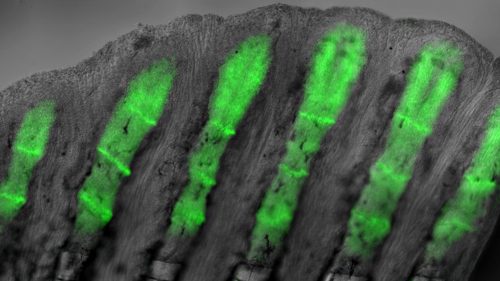Biologists find ‘skin-and-bones’ mechanism underlying zebrafish fin regeneration
Posted by UOregonScience, on 28 March 2017
This Press Release from  the University of Oregon was originally posted on Eurekalert.
the University of Oregon was originally posted on Eurekalert.
EUGENE, Ore. March 28, 2017
University of Oregon biologists have figured out how zebrafish perfectly regenerate amputated fins with a precisely organized skeleton.
Adult zebrafish fins, including their complex skeleton, regenerate exactly to their original form within two weeks after an amputation. The process, they found, is driven by clusters of specialized skin cells that migrate over reforming bones, known as rays, and escort bone cells into the right positions to form individual bones of a branched skeleton.
These skin cells produce a protein called Sonic hedgehog, which interacts with bone-building cells called osteoblasts to promote bone patterning during fin regeneration.
“The orderly reconstruction of zebrafish fins is amazing to see,” said Kryn Stankunas, a professor in the Department of Biology and member of the Institute of Molecular Biology. “Zebrafish fins, which are akin to our limbs, regenerate perfectly. The zebrafish bony rays re-branch just like the original structure. This would be like losing your arm and watching it progressively regenerate complete with a hand and fingers — all the bones restored in their original configuration.”
The findings will not lead to humans re-growing lost limbs, Stankunas said, but such advances in understanding the fundamental processes of regeneration in related vertebrate organisms will inform innovative and targeted therapeutic strategies to improve the repair of broken bones.
“The mechanism — how the skin and bone cells dynamically move and interact using the signaling pathway — is elegant and unexpected, broadening the project’s impact on regenerative medicine,” Stankunas said.
Hedgehog signaling, he added, is also linked to several human cancers.
“The zebrafish fin provides a tractable and simple model to decipher mechanisms of regenerative skeletal patterning,” the researchers wrote in their paper in the March 28 issue of the journal Development, a publication of the non-profit Company of Biologists in the United Kingdom.
Benjamin E. Armstrong, who earned a doctorate in biochemistry in 2016, was the study’s lead author. Scott Stewart, a research professor in the Institute of Molecular Biology, co-directed the project.

The research team used genetically modified zebrafish that produces a fluorescent protein that helps identify the subset of skin and bone cells that respond to Hedgehog signals. The fluorescent marker appears green under the microscope until illuminated with ultraviolet light to photo-convert the green protein to red.
This photo-conversion method revealed that repairing skin cells collectively move towards the tip of the regenerating fin. At particular times, Sonic hedgehog is induced in skin cell clusters that then split into two pools. Simultaneously, the skin cells activate a Hedgehog response in adjacent osteoblasts. That drives them to associate with the skin cells and co-migrate into split groups. The now separated bone cells continue to regenerate replacement bone, but now forming two rays instead of one – a branched skeleton.
“We could see that the bone cells responding to the skin-produced Sonic hedgehog become physically attached to the migrating skin cells”
“We could see that the bone cells responding to the skin-produced Sonic hedgehog become physically attached to the migrating skin cells,” Stewart said. “The pathway is quickly turned off but the now split groups of bone cells will then form two separated mature bony rays connected at a branch point.”
To define the functions of the Hedgehog signaling pathway, the researchers used a new chemical inhibitor, BMS-833923, to turn off Hedgehog signaling in their experimental fish. With Hedgehog blocked, the skin and bone cells failed to interact, and the fin regenerated with stick-like rays rather than forming a branched skeleton.
The inhibitor used in the study is in clinical trials against some forms of human cancers, but it had not been used in zebrafish. The Hedgehog pathway is most associated with basal cell carcinoma and medulloblastoma, Stankunas said.
“The Hedgehog response is absolutely required for branching and not essential for any other aspect of regeneration,” Stankunas said. “Instructions that drive the branching come from the skin cells moving into two groups and likewise dividing the osteoblasts. This is new information. It is the traffic pattern generated by the signaling that regenerates the fin. It is skin and bone working together.”
###
Astra Henner, lab manager and research assistant, was the fourth co-author of the paper.
The National Institutes of Health funded the project through a training grant to Armstrong and research grants to Stankunas and Stewart.
Source: Kryn Stankunas, associate professor of biology, 541-346-7416, kryn@uoregon.edu
Note: The UO is equipped with an on-campus television studio with a point-of-origin Vyvx connection, which provides broadcast-quality video to networks worldwide via fiber optic network. There also is video access to satellite uplink and audio access to an ISDN codec for broadcast-quality radio interviews.
Links
Development Paper: http://dev.
About Stankunas: http://molbio.
About Scott Stewart: http://molbio.
Department of Biology: http://biology.
Institute of Molecular Biology: http://molbio.


 (No Ratings Yet)
(No Ratings Yet)